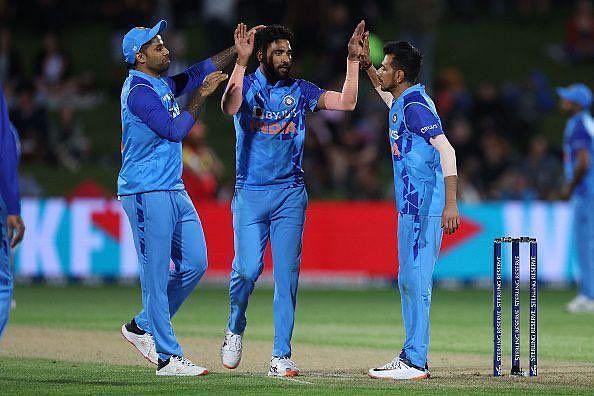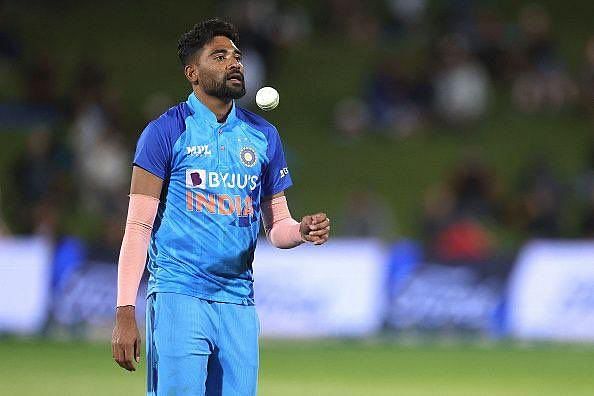
Mohammed Siraj takes another step towards completion of his white-ball evolution
Cast your mind back a few years; there was a time when Mohammed Siraj and his returns in white-ball cricket were ridiculed. On social media, he was looked upon as this bowler who would concede runs, irrespective of the conditions, and that his inclusion in teams would do them more harm than good.
His first few international white-ball games followed a similar script, meaning that people had written him off, even before he had established a foothold on the big stage. But then, like almost all things Siraj, he forced his way into the reckoning, proving to everyone that he was worth a lot more than he was being painted as.
Mohammed Siraj was superb at Napier
The 3rd T20I between India and New Zealand at Napier was the clearest indication yet that this iteration of Siraj is vastly dissimilar to the one that has been the topic of countless memes and ridicule. On a pitch where New Zealand managed 160, he returned with figures of 4-0-17-4. He outwitted Glenn Phillips, arguably the most in-form T20I batter on the planet after Suryakumar Yadav. Siraj also accounted for James Neesham, Mark Chapman and Mitchell Santner.
The manner in which he rushed Phillips into a pull, on a pitch that was not really quick, would be etched in memory for quite some time. The dismissals of Chapman, Neesham and Santner – all accomplished because batters were not ready for what Siraj had up his sleeve, were not bad either.
This spell, though, was not about the wickets he took. Instead, it was about how he, despite all that has been said about him over the years, has managed to evolve a mechanism where he trusts his best ball and backs it to get the better of any batter.
This has been a long time coming. Those who have only watched the IPL might even say that this version of Siraj is unrecognizable from the one that they have known – a version that often ships too many runs and does not have enough wickets to show. But he has gotten here through sheer hard work, and he must be given credit for evolving his white-ball game in such a fashion.
At Napier, stroke-making was never going to be easy. Still, the Kiwis found themselves in a position to get close to 180 after 15 overs. Well, until they ran into Siraj.
Phillips' dismissal triggered a monumental collapse that allowed India to tighten the noose and restrict the hosts to a chaseable total. In the end, rain and a bit of batting hara-kiri meant that the visitors could only tie the game. Things, however, would have been worse had Siraj not sprinkled his magic on the match earlier.
This is not a one-off incident either. Since returning to the ODI fold in 2022, the Royal Challengers Bangalore pacer has conceded more than six runs per over in a spell only twice (out of 12). In T20Is, he has been expensive on a couple of occasions, most notably against New Zealand at Jaipur and against South Africa at Indore. But when he has hit his straps, he has looked as penetrative as any Indian bowler out there.
The biggest improvement Siraj seems to have made is with respect to his accuracy. Earlier, he was prone to trying things out, dishing up loose deliveries that would release pressure. That has not entirely gone away, although the frequency has reduced massively. For context, only eight of the 17 runs he conceded at Napier came via boundaries.
Even when he was shipping runs, many were inclined to look the other way because of the wicket-taking threat that he carried. The wicket-taking threat, if anything, has grown, meaning that with greater control, he is close to becoming the ideal T20I bowler.
That said, there is still a lot of work to do. He has shown his brilliance in patches and it remains to be seen if he can operate as India’s spearhead in the shortest format. If his Test and ODI exploits are anything to go by, though, it seems that might not be a problem.
And that is the quality that has endeared the team management to him. He bowls his heart out, irrespective of the conditions and the opposition. He never thinks he is out of the game, irrespective of how many runs he has conceded previously, and bowls as if he is bowling for the last time ever in competitive cricket.
These traits do not find a mention in any statistical account, nor are they distinguishing factors for the social media jury. But they are important, especially in Siraj’s case. Not because it is emblematic of everything he does, but also because it is now starting to reflect in his numbers.
Not long ago, Siraj was this bowler that everyone would turn to and ridicule, just because he had a reputation of run-concession that preceded him. Whenever he ships a truckload of runs next, expect that to continue. What has changed now, though, is that those instances have reduced considerably.
He is not the finished article yet. Even he would admit that he has to add several strings to his bowling bow to become the all-format behemoth he thinks (and knows) he can become. What can’t be denied, however, is that with every such display, he is inching a step closer to the completion of his white-ball evolution.
Some thought he would never get here. In a nutshell, that is Siraj. You write him off and he comes back with renewed vigour, and an answer to all the questions posed. Cricketers like that don’t come around often. Bowlers like Siraj don’t come around often either.




